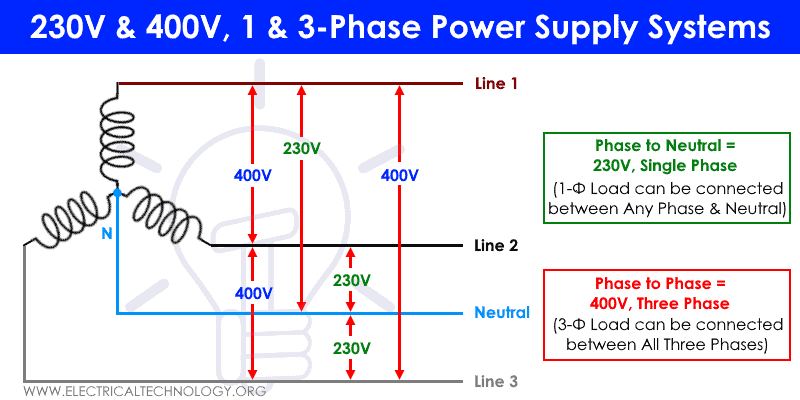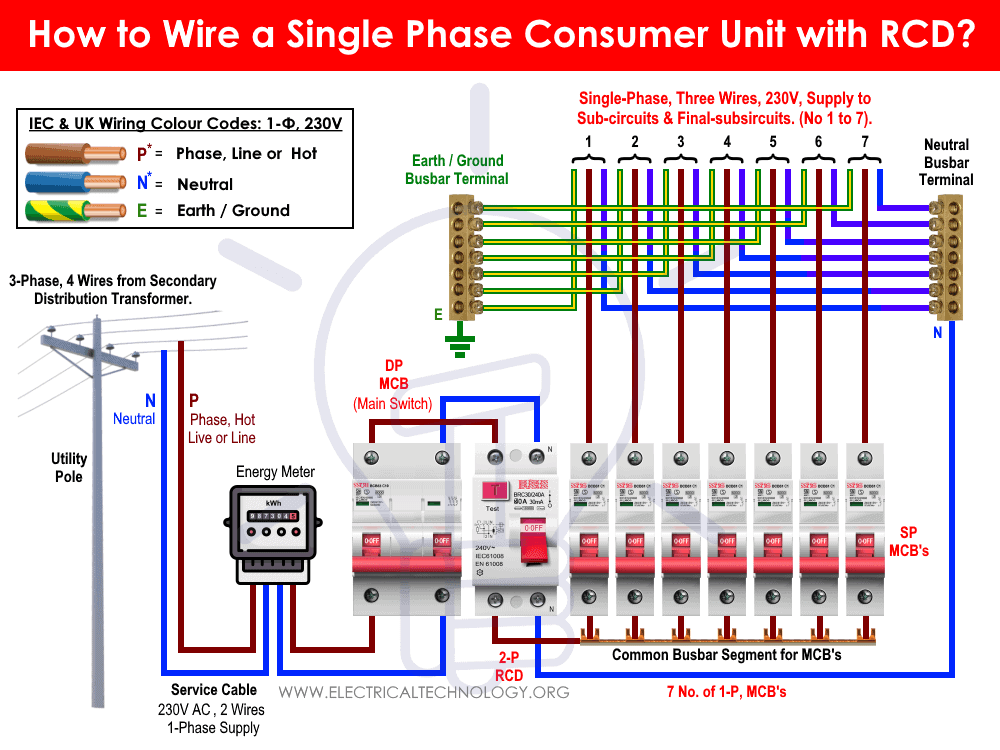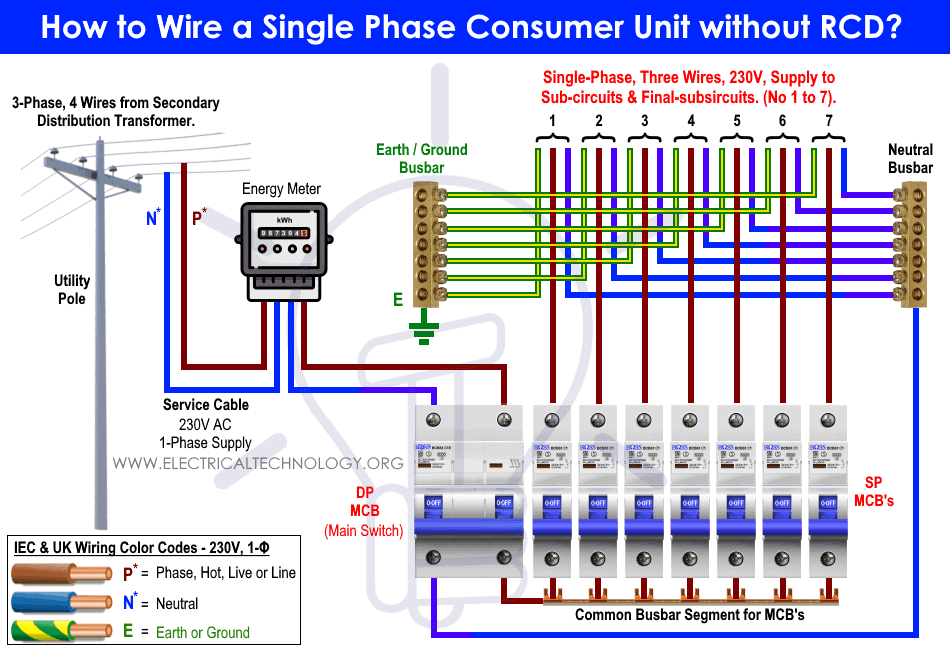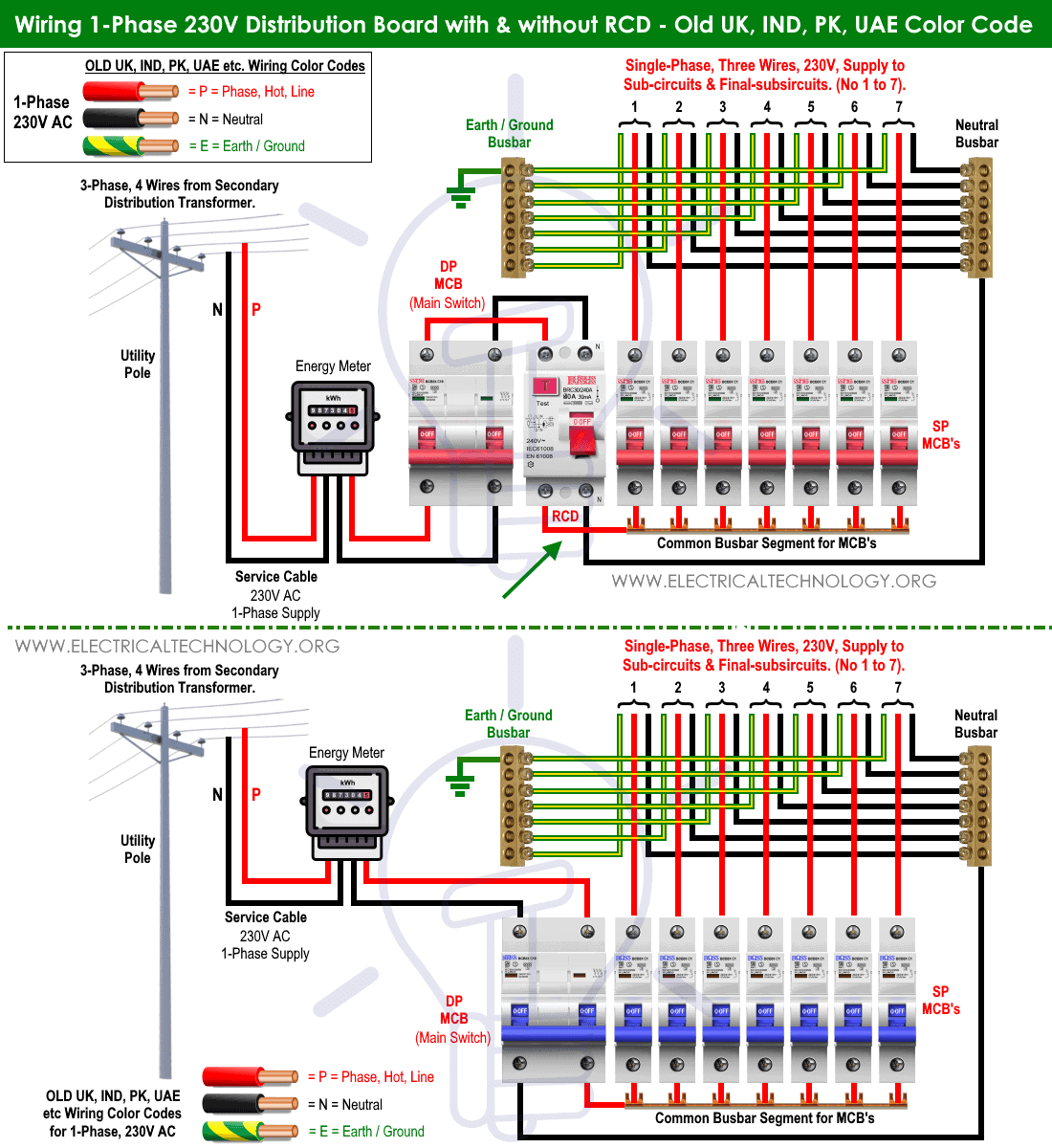Wiring a 1-Φ, 230V Consumer Unit & Distribution Board with & without RCD: IEC, EU & UK
What is a Consumer Unit?
A consumer unit (CU) also known as panel box, breaker box or fuse box is a type of a distribution board (aka electric panel, breaker panel, panelboard or main breaker-box or main service panel) which is used to distribute and fed the electric power to the sub-circuits and final sub-circuits especially in residential and domestic applications.
In the UK and EU, the consumer unit is used to provide single phase, 230V AC supply to the load points through a properly protected system. The CU contains multiple protective devices such as isolator switches, circuit breaker and fuses to safely carry the electric power through cables and wires to the load points such as electric water heaters, air-conditioner, electric motors and lighting circuits etc.
The following different types of distribution and consumer units are used for single phase supply in residential applications.
- Main Distribution Board: It is the main circuit breaker panel box connected to the incoming power supply from the secondary of the transformer through an energy meter and an isolator switch.
- Sub Distribution Board: It is a type of subsidiary distribution board which distributes electric power within a selected area in a building such as a specific flour in a multistorey building.
- Final Distribution Board: It is a type of distribution board which is used to provide electric supply to the final and sub final circuits such as the switchboard in a room for lighting and ceiling fan control etc.
Related Post:
- How to Wire 1-Phase Split Load Consumer Unit? – RCD+RCBO
- How to Wire 230V Dual Split Load Consumer Unit? – RCD+MCB
In this tutorial, we will be showing how to wire a single phase consumer unit for 230V with and without RCD’s according to IEC. We will be using the IEC wiring color codes which is also applicable to EU, UK and other countries. For proper explanation, the Old UK wiring color codes (prior 2004) are also used which is still applicable in some of the countries such as India, Pak, UAE, KSA etc.
As most countries follow the same voltage system for distribution for both single phase and three phase supply systems as shown in the following fig. Keep in mind that the voltage system in the US and Canada is far different than the UK and EU. The single phase supply in the UK & EU is 230V (Phase to Neutral) where the single phase supply in US is 120V, 208V, 240V (split phase), 277V and 480V. On the other hand, the three phase supply voltage in the UK and EU is 400V (between all three lines or line to line) whereas, the three phase voltage in the US is 480V, 208V, 240V and 480 V.
There are multiple ways of consumer unit wiring and installation to provide circuit protection such MCB + CB’s, MCB + RCD’s + CB’s, MCB + RCBO + RCD’s + CB’s, Single circuit, dual and split circuit, split phase circuits etc. We will discuss them in the upcoming posts.
For example, In case of failure of one RCD in an MCB + RCD’s consumer unit, the rest of the circuits protected by other RCD’s and CB’s will work fine.
On the other hand, another possible (but costlier than the RCD+MCB) solution is to protect each circuit through RCD + RCBO in accordance with 17th Edition. In this scenario, If a single RCBO trips out, only the related circuit will power OFF and the rest circuits will work properly. In addition, you may know the Difference Between MCB, MCCB, ELCB & RCB, RCD or RCCB/RCBO Circuit Breakers for better understating of the functions of RCD circuit breakers.
Components Required:
- Consumer Unit or Distribution Board
- Two Poles Main Switch MCB.
- Two Poles RCD (Residual Current Device).
- 7 No of Single Poles MCB’s
- Cable & Wires.
Related Post:
How to Wire a Single Phase Consumer Unit with RCD?
According to IET (Institution of Engineering and Technology) wiring regulations: 17th Edition (BS 7671:2008 – 1: 2011), an RCD protection must be provided in the consumer unit except smoke and burglar alarms system.
In both (MCB and RCBO) cases, almost all the consumer units up to 100 Amps (including the basic 63A CU) and distribution boards up to 200 Amps included the MCB’s and RCD’s mounted on DIN rail in the panel board.
In a single phase 230V AC supply system, the main power supply from the secondary side of the distribution transformer (Primary Star or Y, and Secondary as Delta where voltage between any line and neutral wire is 230V, 1-Φ) is connected to the energy meter. There may be a main fuse between the utility pole and energy meter (kWh meter) to isolate the power supply while troubleshooting / installing a kWh energy meter.
The two wires from the energy meter enter the consumer unit and connect to the double pole MCB as the main switch. The output two wires from the main switch enters to the two pole RCD. Keep in mind that proper wiring is needed in case of RCD breaker.
In other words, the main switch (as MCB) will work properly no matter if the two wires (as phase and neutral) connect to the down or up side terminals. But this is not the case in case of residual current device (RCD). The output of the MCB must be connected to the Input terminals of RCD. In addition, The neutral wire (both Input & Output) should be connected to the “N” terminal mentioned on the RCD nameplate.
Now, the Phase (also known as Hot, Line or Live) from the RCD is connected to all the seven numbers of the single pole circuit breakers (MCB’s) via common busbar segment. The Neutral from the RCD is connected to the Neutral busbar terminal.
Finally, the load points i.e. lighting and socket outlets etc. are connected via three wires (Phase “P”, Neutral “N” and Earth “E” or “PE” as protective earth). The earth busbar terminal is connected to the main earthing / grounding system (through earthing conductor –> earth rod –> and finally earth plate buried in the soil.
Note: We have used “Brown” for Phase, “Blue” for Neutral and “Green or Green with yellow stripe ” for earth wires according to IEC, UK and EU wiring color codes. You may use the local and specific area color codes if applicable.
Click image to enlarge
Related Posts:
- Single Phase Electrical Wiring Installation in Home – NEC & IEC
- Three Phase Electrical Wiring Installation in Home – NEC & IEC
How to Wire a Single Phase Consumer Unit without RCD?
According to pre-17th edition wiring regulations, RCD protection in consumer units were only presented to some of the socket outlets. The rest of the circuits were without RCD’s protection. In addition, there were no concept of split busbars and RCD before 1990. Some of the old areas may still find these kinds of consumer units without RCD protection as follows.
This is the same wiring tutorial as mentioned above except there is no RCD used in the CU. In other words, the main power supply is connected to the SP circuit breakers through the main switch and the rest load circuits and outlets are connected via Phase, Neutral and Earth wires.
Click image to enlarge
P.S: As mentioned before, RCD protection is must in the consumer unit according to the IEC and 17th edition.
Related Posts:
Related Posts:
- How to Wire a Three Phase, 400V Distribution Board? IEC & UK
- How to Wire Combo of 3 & 1-Φ, 400V/230V Distribution Board?
Consumer Unit Wiring with & without RCD – Old UK Wire Color Codes
The following fig shows the basic consumer unit wiring installation with and without RCD protection for 230V single phase AC supply according to the Old UK (prior 2004) wiring color codes. As these wiring color codes are still applicable in many countries such as India, Pakistan, United Arab Emirate, Kingdom of Saudi Arabia, Qatar, Kuwait and other Arab countries, they may follow these wiring color codes. For example, the “Red” for Phase, “Black” for Neutral and “Green” for earth wires.
Click image to enlarge
Related Posts:
- How to Wire 240V, 208V & 120V, 1 & 3-Phase, High Leg Delta Main Panel?
- How to Wire 277V & 480V, 1-Phase & 3-Phase, Commercial Main Service Panel?
Wiring Load Circuits in 230V Single Phase Consumer Unit
The following fig shows how to connect single phase load points such as LCD TV, LED Lamp, Ceiling Fan and standard socket outlet etc. in a single phase 230V consumer unit and distribution board. As shown, all the load points should be directly connected to the 230V AC supply via Phase, Neutral and Earth/Ground wires.
As shown in the fig below, all the load circuits are protected by Main MCB –> RCD –> and CB circuit breakers. You may connect and install additional RCBO and RCD’s as per code and requirement.
IEC Wiring Color Codes – 1-Φ, 230V & 3-Φ, 400V: UK & EU
Keep in mind that we have used IEC wiring color codes for illustration purposes only. If not applicable, Please follow the local area codes or general practiced color codes related to specific regions.
In the tutorials above, We have used the IEC wiring color codes (applicable to EU, UK and other countries) as follows.
IEC Wiring Color Codes for 230V, 1-Phase, 2-Wire System
- Brown = Phase or Line Wire
- Blue = Neutral Wire
- Green or Green with Yellow Stripe = Ground or earth wire as protective earth (PE).
IEC Wiring Color Codes for 400V, 3-Phase, 4-Wire System
- Brown = Phase 1 or Line 1
- Black = Phase 2 or Line 2
- Gray = Phase 3 or Line 3
- Blue = Neutral Wire
- Green or Green with Yellow Stripe = Ground or earth wire as protective earth (PE).
Related Posts:
- How to Wire 120V & 240V Main Panel? Breaker Box Installation
- How to Wire 208V & 120V, 1-Phase & 3-Phase Main Panel?
Safety Precautions
- Disconnect the power supply (and make sure it is really swathed OFF) before servicing, repairing or installing electrical equipment. To do so, switch off the main switch in the main consumer unit or distribution board.
- Never stand or touch wet and metal parts while repairing or installation.
- Read carefully all the cautions and instructions and follow them strictly while doing this tutorial or any other work in practical related to electrical works.
- Always, use the right size cable and wire, proper size outlets and switch and suitable size of circuit breakers. You may also use the Wire and Cable size calculator to find the right gauge size.
- Never ever try to play with electricity (as it is dangerous and can be fatal) without proper guidance and care. Do the installation and repairing work in presence of experienced persons having vast knowledge and good practice who knows how to deal with electricity.
- Doing your own electrical work is dangerous as well as illegal in some cases. Contact the licensed electrician or the electric power supply provider before practicing any change/modification in electrical wiring connections.
- The distribution board should not be installed 2.2 meter above the floor, must be protected from the corrosion and away from watery areas. All the wires should be covered in the panel board (i.e. it should not hang outside the panel). Finally, there must be a safety sign near the distribution board.
- The author will not be liable for any losses, injuries, or damages from the display or use of this information or if you try any circuit in wrong format. So please! Be careful because it’s all about electricity and electricity is too dangerous.
Related Wiring Installation Tutorials:
- How to Wire and Install an Electrical Outlet Receptacle?
- How to wire a GFCI Outlet?
- How to Wire an AFCI Outlet?
- How to Wire Combo Switch and Outlet?
- How to Wire GFCI Combo Switch and Outlet
- How to Wire an AFCI Combo Switch
- How to Wire a GFCI Circuit Breaker?
- How to Wire an AFCI Breaker?
- Staircase Wiring Circuit Diagram – How to Control a Lamp from 2 Places?
- Corridor Wiring Circuit Diagram – Hallway Wiring using 2-Way Switches
- Tunnel Wiring Circuit Diagram for Light Control using Switches
- Hospital Wiring Circuit for Light Control using Switches
- Hotel Wiring Circuit – Bell Indicator Circuit for Hotelling
- Hostel Wiring Circuit Diagram and Working
- Godown Wiring Diagram – Tunnel Wiring Circuit and Working
- How to Wire 120V Water Heater Thermostat – Non-Simultaneous?
- Single-Phase Electrical Wiring installation in a Multi-Story Building
- 3-Phase & 1-Phase Electrical Distribution Wiring Installation in Multistory Building
- Even More Electrical Wiring Installation & Tutorials





 How Does the Grounding System Work in Aircraft & Submarines?
How Does the Grounding System Work in Aircraft & Submarines? What is the Correct Wire Size for 100A Breaker and Load?
What is the Correct Wire Size for 100A Breaker and Load? What is the Right Wire Size for 90A Breaker and Load?
What is the Right Wire Size for 90A Breaker and Load? What is the Correct Wire Size for 80A Breaker and Load?
What is the Correct Wire Size for 80A Breaker and Load? What is the Suitable Wire Size for 70A Breaker and Load?
What is the Suitable Wire Size for 70A Breaker and Load? IEC and BS 7671 Requirements for Consumer Unit and Distribution Board
IEC and BS 7671 Requirements for Consumer Unit and Distribution Board